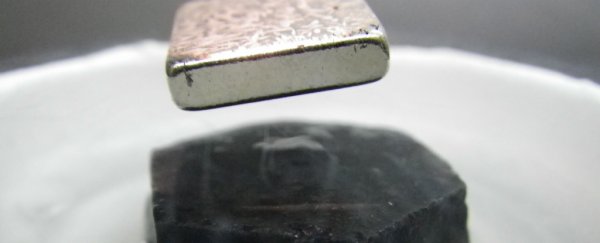Physicists have found the first experimental evidence of important new properties of high-temperature superconductivity, and it could help them work out how to achieve this exotic state reliably in materials at room temperature.
Superconductivity is so lucrative because it allows electricity to be conducted with almost no resistance - in other words, it could revolutionise the way we use energy by building super-efficient electricity grids, and don't even get us started on its ability to levitate trains. But first, we need to work out how to reliably make materials superconductive without needing to cool them down to near absolute zero (–273.15 degrees Celsius), which is where this new research might come in handy.
To understand the new findings, you first need to understand how conventional superconductivity works. This happens when materials are cooled down to the aforementioned super-cold temperatures, and their electrons suddenly pair up, allowing them to conduct electricity with almost perfect efficiency.
Using special materials, scientists have also managed to achieve superconductivity at higher temperatures – in fact, in 2014, they even got it happening at room temperature – but the process is unreliable at best, and researchers still can't predict how and why this happens.
So a team of physicists led by the University of Waterloo in Canada set out to investigate exactly what's going on in these high-temperature superconductors - the idea being that once we can understand the process better, we'll be able to tweak it to make sure it happens regularly and at the highest temperatures possible.
What they found was the first direct experiment evidence of something called electronic nematicity, which occurs when electron clouds snap into an aligned and directional order, such as stripes and grids, in certain types of high-temperature superconductors.
"It has become apparent in the past few years that the electrons involved in superconductivity can form patterns, stripes or checkerboards, and exhibit different symmetries – aligning preferentially along one direction," said lead researcher David Hawthorn. "These patterns and symmetries have important consequences for superconductivity – they can compete, coexist or possibly even enhance superconductivity."
Hawthorn and his team used a technique called soft x-ray scattering to watch this happening in materials called cuprates – a type of copper-oxide ceramic that's known to be the very best of the high-temperature superconductors.
It's the first time anyone had done this, and they found some interesting alignments happening, which they believe could be the key to working out why the materials sometimes do or don't achieve superconductivity at high temperatures.
"In this study, we identify some unexpected alignment of the electrons – a finding that is likely generic to the high-temperature superconductors and in time may turn out be a key ingredient of the problem," said Hawthorn.
Their observations also suggest that nematicity generally occurs in all cuprates once the temperature drops below a critical point.
The challenge now is to understand how nematicity relates to a phenomenon known as charge density wave fluctuations, which sounds complicated, but actually makes quite a lot of sense.
"Normally, the electrons are in a nice, uniform distribution, but charge-ordering can cause the electrons to bunch up, like ripples on a pond," explained the University of Waterloo. "This sets up a competition, whereby the material is fluctuating between the superconducting and non-superconducting states until the temperature cools enough for the superconductivity to win."
The team will explore this next, and will then start working on how they can use electron nematicity as a 'knob' they can tune, with the ultimate goal of achieving a reliable room temperature superconductor. The research has been published in Science.
There's still a lot of work to be done, but understanding what's going on inside this super exciting state of matter takes a step closer to eventually being able to master it – and that could have world-changing consequences.
